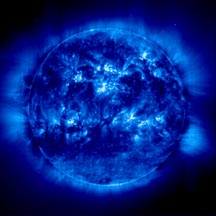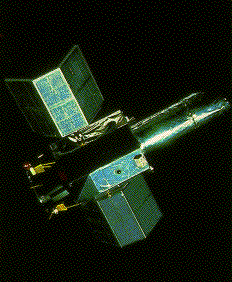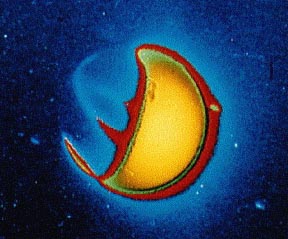 |
|
|
|
||||||
Ultraviolet Waves

Scientists have divided the ultraviolet part of the spectrum into three
regions: the near ultraviolet, the far ultraviolet, and the extreme
ultraviolet. The three regions are distinguished by how energetic the
ultraviolet radiation is, and by the "wavelength" of the ultraviolet light,
which is related to energy.
The near ultraviolet, abbreviated NUV, is the light closest
to optical or visible light. The extreme ultraviolet, abbreviated EUV,
is the ultraviolet light closest to X-rays, and is the most energetic of the
three types.
The far ultraviolet, abbreviated FUV, lies between the near
and extreme ultraviolet regions. It is the least explored of the
three regions.
Though some ultraviolet waves from the Sun penetrate Earth's atmosphere, most of them are blocked from entering by various gases like Ozone. Some days, more ultraviolet waves get through our atmosphere. Scientists have developed a UV index to help people protect themselves from these harmful ultraviolet waves.
How do we "see" using Ultraviolet light?It is good for humans that we are protected from getting too much ultraviolet radiation, but it is bad for scientists! Astronomers have to put ultraviolet telescopes on satellites to measure the ultraviolet light from stars and galaxies - and even closer things like the Sun!
What does Ultraviolet light show us?We can study stars and galaxies by studying the UV light they give off - but did you know we can even study the Earth? Below is an unusual image - it is a picture of Earth taken from a lunar observatory! This false-color picture shows how the Earth glows in ultraviolet (UV) light.
Many scientists are interested in studying the invisible universe of
ultraviolet light, since the hottest and the most active objects in the
cosmos give off large amounts of ultraviolet energy.
The image below shows three different galaxies taken in visible
light (bottom three images) and ultraviolet light (top
row) taken by NASA's Ultraviolet Imaging Telescope (UIT) on the
Astro-2 mission.
  The difference in how the galaxies appear is due to which type of stars shine brightest in the optical and ultraviolet wavelengths. Pictures of galaxies like the ones below show mainly clouds of gas containing newly formed stars many times more massive than the sun, which glow strongly in ultraviolet light. In contrast, visible light pictures of galaxies show mostly the yellow and red light of older stars. By comparing these types of data, astronomers can learn about the structure and evolution of galaxies.
[NEXT LONGER WAVELENGTH] [NEXT SHORTER WAVELENGTH] |




